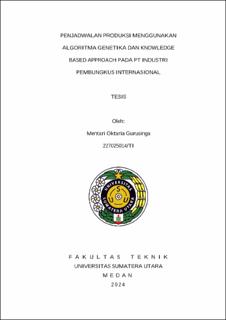Penjadwalan Produksi menggunakan Algoritma Genetika dan Knowledge Based Approach pada PT Industri Pembungkus Internasional
Production Scheduling using Genetic Algorithm and Knowledge Based Approach at PT Industri Pembungkus Internasional

Date
2024Author
Gurusinga, Mentari Oktaria
Advisor(s)
Ginting, Rosnani
Sinulingga, Sukaria
Metadata
Show full item recordAbstract
Production planning and operational scheduling very important for
complexity of production system. The existence rules of delivery ontime, order
arrival flexibility, differences of priorities, mixed production volumes, differences
of machine capabilities cause uneven capacity utilization, job accumulation, and
production delays. This study aims to handle parallel machine scheduling to get
the best job sequence results to minimize job delays using genetic algorithms and
knowledge based approaches (KBA). Genetic algorithms are one of the algorithms
that have succeeded in finding solutions to optimization problems by applying the
evolution process and eliminating bad solutions. KBA helps decision-making solve
problems related to create a computing system imitates human intelligent behavior.
The combination of the methods and earliest due date (EDD) rule produce an
inference engine to build more adaptive initial population. The results of the
proposed scheduling show the new rules successfully guide the search process
more adaptive. The genetic operation process increases the fitness value from the
initial initialization to the end of genetic operation process when the job is
overloaded or underloaded. When overload, the fitness value increases by 0.95%,
total number of job delays in initialization decreases from 198 jobs to 184 jobs and
the average load capacity ratio (LCR) decreases by 7.54%. When the job
underload, the fitness value increases by 3.56%, there are no job delays, and the
LCR increases by 4.66%. The results of the proposed job scheduling sequence can
meet the company's objectives by reducing lateness and increasing fitness values.
The implementation of the integration of the two methods with the VB.Net
programming language requires an average computing time of 32 seconds when
running.
Collections
- Master Theses [185]
